Hydrangea paniculata (lat. Hydrangea paniculata) is a shrub with a height of 0.5 m to 3 m. It is characterized by inflorescences in the form of a panicle, consisting of many flowers. Most species are able to change the color of the inflorescences: from white to gray-green and cherry.
Review of varieties of paniculata hydrangea from Natalia Samoilenko
Honey-bearing inflorescences are broad pyramidal panicles up to 30 cm long and consist of large sterile flowers up to 2.5 cm in diameter, the greenish-white petals of which gradually turn pink, and small reproductive white flowers with early falling petals. Even in late autumn, the inflorescences do not lose their attractiveness—they can be used as winter bouquets.
| Content:
|
The leaves of hydrangea paniculata are ovoid or elliptical, up to 15 cm long. The crop blooms for the first time at the age of 4-5 years. It forms well, can be grown in standard form, and will become the best background for a flower arrangement.
This type of hydrangea combines high decorativeness, frost resistance and unpretentiousness in cultivation. This article contains descriptions of the best varieties of paniculata hydrangea with names and photos; they will help you choose plants that can fully grow in the Middle Zone and Siberia.
The best winter-hardy varieties for the Moscow region
Since the Moscow region has unfavorable climatic conditions in winter, not all plant varieties can be cultivated in open ground in this area.
Limelight

Limelight
The Limelight variety is attractive to gardeners due to its original color, frost resistance, strong stems, and large flowers. Its inflorescences are not equally colored in different light conditions. At the beginning of flowering, the petals are colored soft green. If the plant is in the shade, the flowers will remain green until autumn.When grown in the sun, the green color changes to white, and by autumn it turns to pink. The inflorescences have a delicate aroma.
- Fast-growing shrub, height 1.5-2.5 m, rounded crown. The stems are strong, the annual growth is 25-30 cm.
- The inflorescences are wide-pyramidal, dense, 25-30 cm long. The leaves are velvety, wide, green, with a purple tint appearing in autumn.
- Flowering: July-September.
- Frost resistance: -35°С, zone 4.
It is necessary to insulate Limelight hydrangea for the winter only in the first 2-3 years after planting.
Vanilla Fraise
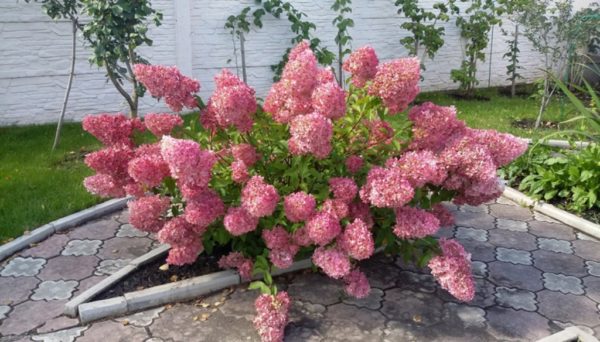
Vanilla Fraise - one of the best varieties
The Vanille-Fraise variety attracts attention with the unusual color of its inflorescences. At the beginning of flowering they have a creamy hue, and then gradually change it to bright pink tones from the base of the inflorescence cone to its top. The branches bend under the weight of large inflorescences, giving the bush a weeping shape. The shrub grows well in a sunny place, but forms larger inflorescences in partial shade.
- The height of the bush is 1.5-2 m, the crown is spreading.
- The inflorescences are conical, dense, 30 cm long.
- Flowering: June-October.
- Location: light partial shade.
- Frost resistance: -35°C, zone 4. Does not require shelter for the winter in the Middle Zone and Northern regions.
In the fall, it is worth cutting several inflorescences and drying them into a winter bouquet to decorate your home interior.
Bobo
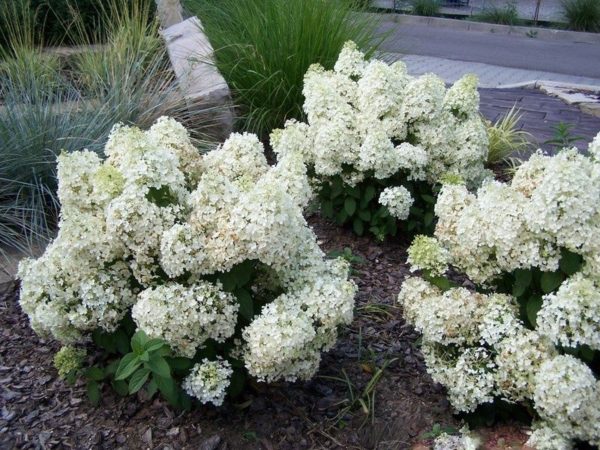
Bobo
A dwarf hydrangea variety that gardeners immediately fell in love with. The color of the petals gradually changes from lemon green to white, and then to pale pink. When grown in the southern regions, Bobo hydrangea is planted in semi-shaded areas; in the central zone and northern Russia - in well-lit or slightly shaded areas.
- Height: 0.6-0.7 m.
- The inflorescences are conical, 15-20 cm long. The leaves are green, the autumn color is yellow.
- Flowering: July-September.
- Frost resistance: -34, zone 4.
In 2011, he received an award at the Florall exhibition in Belgium as the best variety of paniculata hydrangea.
Kyushu
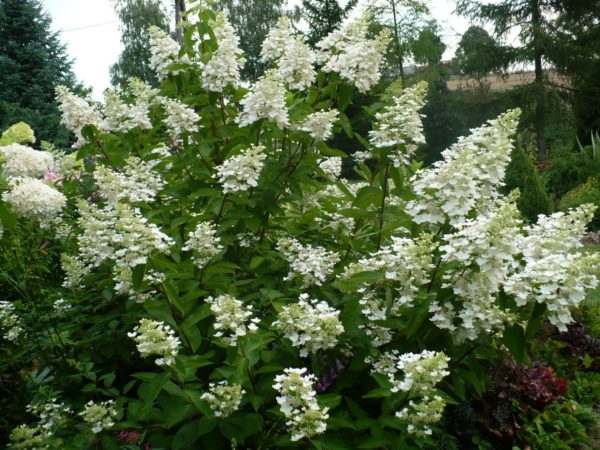
Kyushu
Shrub with a dense spreading fan-shaped crown. Perky large sterile flowers are scattered among the small reproductive flowers. During the blooming period, the buds have a creamy tint, at the time of flowering they are white, and in autumn they are pink. Loves partial shade and an area protected from the wind. The Kyushu variety is considered a good honey plant and has a pleasant aroma.
- Height: 3 m.
- The inflorescences are pyramidal, large, 20-35 cm long.
- Flowering: June-October.
- Frost resistance: -34°C, zone 4.
The variety is suitable for creating a hedge, while at the same time providing an excellent background for garden plants.
Pink Diamond
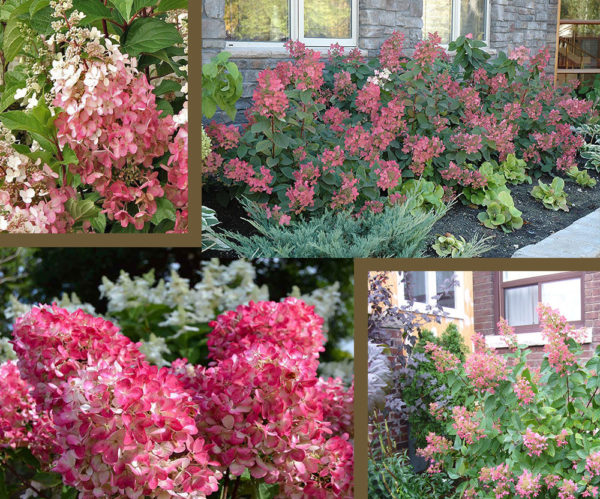
Pink Diamond
Pink Diamond or Pink Diamond is an excellent variety with beautiful, large panicle inflorescences and long-lasting flowering. At first the petals are white, and closer to autumn the color changes to coral pink.
- Height: 2.5-3 m.
- The inflorescences are conical, large, 15-30 cm long. The leaves are green with a matte tint and a rough surface.
- Flowering: July-September.
- Frost resistance: -30°С, zone 4.
In case of various damages, Pink Diamond recovers very quickly. Adapted for growing in urban conditions.
Pink Lady
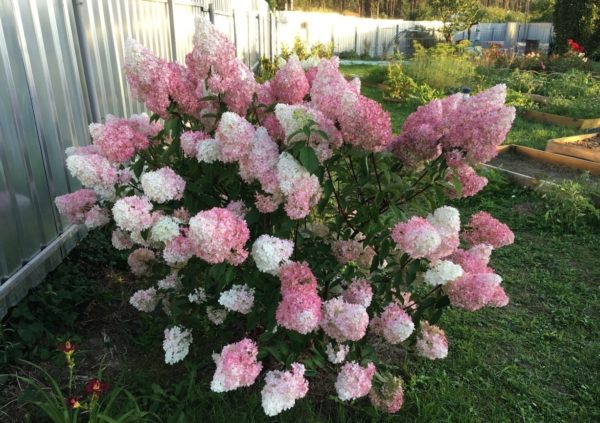
Pink Lady
The flowers are white, gradually turning pink in autumn, collected in large inflorescences. Numerous wide cones of inflorescences consist mainly of large sterile flowers. Flowering is abundant and long lasting. The variety is moisture-loving and intolerant to drought.Prefers fertile, loose, acidic soils.
- Height: 1.5-2 m.
- The inflorescences are wide-conical, 30 cm long. The leaves are large, dense, bright green.
- Flowering: July-October.
- Winter hardiness: -29–30°С, zone 4.
For abundant flowering, it is recommended to carry out annual spring pruning before the start of the growing season.
Levana
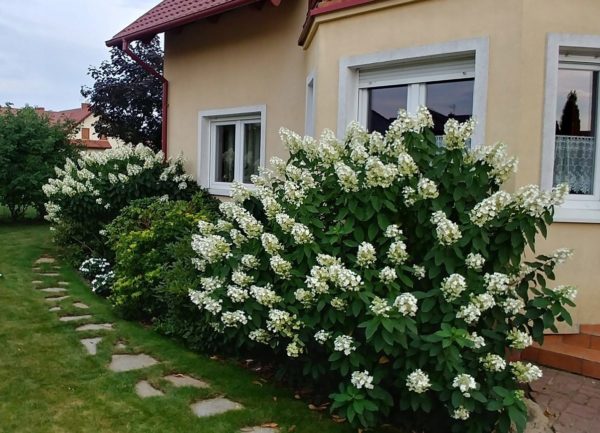
Levana
A fast growing hydrangea variety. Does not require a garter. The flowers remain white almost until the end of flowering, but sometimes the petals at the base of the panicle cone may take on a slight pink tint. It prefers soils rich in humus, but can grow on any soil, tolerates short-term flooding, and can grow in the sun and shade. Widely used for landscaping parks and recreation areas.
- Height: up to 3 m. Shoots are straight, strong, light brown in color.
- The inflorescences are huge, 30-50 cm long.
- Flowering: July-October.
- Frost resistance: -34°C, zone 4.
Gardeners in the Moscow region consider this variety to be the best, as the plant attracts bees to the garden with its pleasant aroma.
White varieties of hydrangea paniculata
Magical Starlight
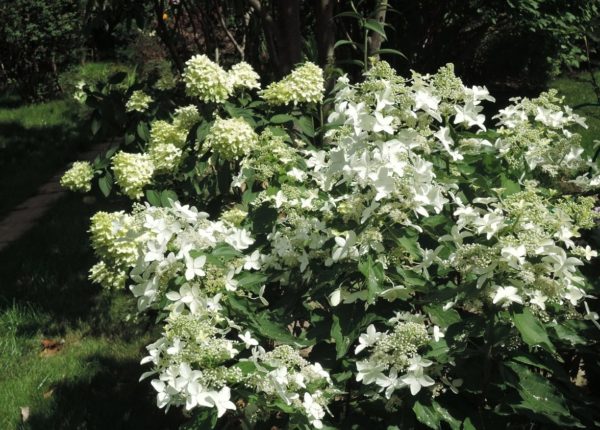
Magical Starlight
An excellent representative of white-flowering hydrangea varieties. The bush does not require garter, as the shoots are strong and red-brown. Sterile flowers are distributed unevenly in the inflorescence. Prefers humus-rich, slightly acidic soils.
- Height: 1.5-1.7 m. The crown is spherical.
- The inflorescences are loose, cone-shaped, 15-20 cm long. The leaf is green, rough, large, oblong and pointed.
- Flowering: June-September.
- Frost resistance zone: -29 °C, zone 4. Winter hardiness increases with age.
It is possible to grow the Magical Starlight variety in standard form.
Pearl of the Festival
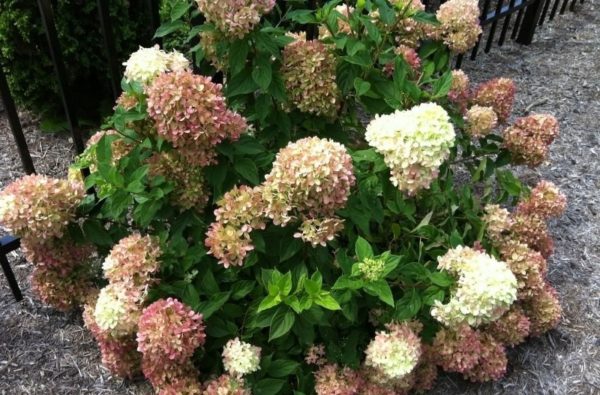
Pearl of the Festival
Growth vigor is moderate. Flowering is abundant and long lasting. At first the flowers are cream with a greenish tint, then snow-white with a light green-pink edging. Towards the end of the season, the inflorescence becomes bright pink, and at the end of flowering a light coffee color appears.
- The height of the bush is average, 1.5 m. The crown is compact and round.
- The inflorescences are pyramidal with a rounded apex, 15-20 cm long.
- Flowering: June-October.
- Frost resistance: -29°C, zone 4.
For this variety it is necessary to carry out formative pruning, otherwise the bush will not develop normally. Sometimes there may even be almost no flowering at all.
Polar Bear (Polar beer)
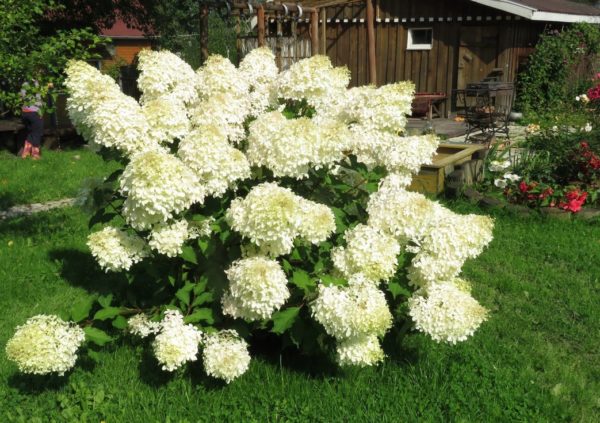
Polar Bear (Polar beer) - one of the best white varieties
Variety "Polar Bear" with white inflorescences, it is unpretentious to growing conditions, resistant to high and low temperatures, diseases and pests. Beautiful and large panicles. Polar beer is an excellent honey plant, so it is often grown in apiaries.
- Height: 1.5-2 m.
- The inflorescences are large.
- Flowering: July-September.
- Frost resistance: -30°C, zone 4.
Hydrangea Polar Bear will decorate your site until late autumn; the bushes continue to bloom almost until frost.
Summer Snow
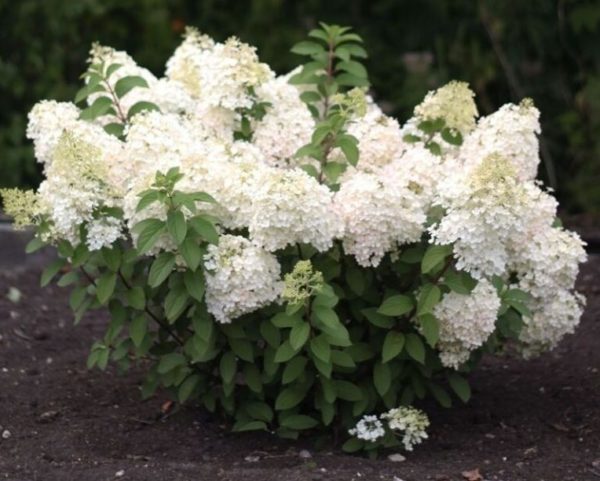
Summer Snow
Hydrangea 'Summer Snow' low growing shrub. The flowers are white, with a slight hint of pink at the end of bloom. It blooms already in the year of planting. Easy to grow in a container, irreplaceable in small gardens, looks good in various compositions, in parks, in hedges, like a tapeworm.
- Height: 1.5 m.
- The inflorescences are dense and compact.
- Flowering: July-September.
- Frost resistance -30°C, zone 4.
Since the bush grows quite spreading, it is recommended to plant it no closer than 1 meter from the paths, otherwise it will interfere with the passage.
Goliath
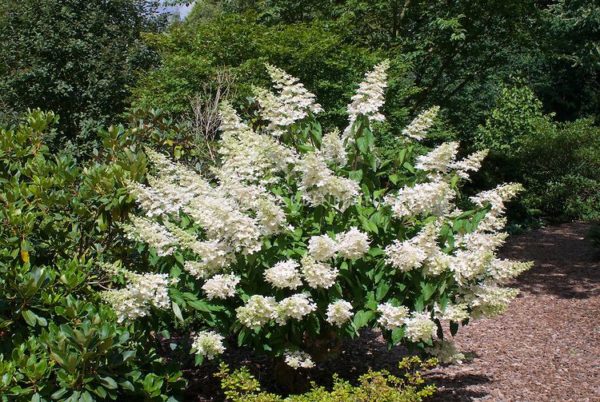
Goliath
The inflorescences are large, white, turning pale pink with age. Planting singly or in groups, prefers slightly acidic soil, moderate watering.
- Large shrub up to 3 m in height and width, shoots are straight.
- Inflorescences are conical, narrow.
- Flowering: June-August.
- Frost resistance: -35°C, zone 4. Winters without shelter
An extremely unpretentious variety of hydrangea: it is rarely damaged by diseases and pests, can grow on any soil, in open areas and in partial shade, and tolerates short-term stagnation of moisture.
Prim White
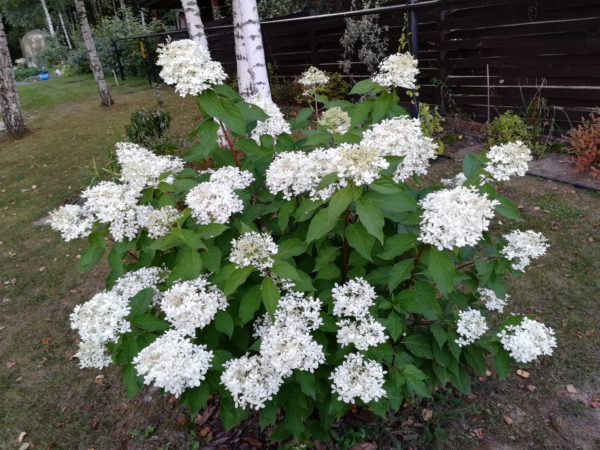
Prim White
An excellent early flowering variety. The inflorescences consist of many large sterile flowers. In the bud phase, the color of the petals is creamy, and when fully bloomed, they are snow-white. Under favorable conditions, repeated flowering is possible. The bush is dense, branched, with a regular crown. Prefers fertile soils, well-lit places, but easily adapts to unfavorable conditions.
- Height: 1.5 m. The shoots are thin, branched, gray-green in color.
- The inflorescences are small, slightly flat. The leaves are pale green, sitting on bright red petioles.
- Flowering: June-September.
- Frost resistance: -35°C, zone 4.
Experts recommend pruning shoots immediately after flowering, shortening faded branches and cutting out weak ones.
Baby Lace
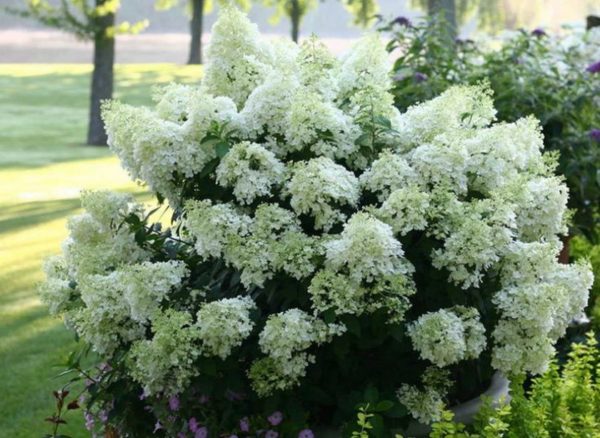
Baby Lace
Baby Lace won a gold medal at the Plantarium 2015 exhibition. The compact hydrangea blooms annually and luxuriantly on the stems of the previous and current year. Inflorescences abundantly cover the bush.The flowers bloom white and turn pink in autumn. Unpretentious, not susceptible to diseases. Suitable for single and group plantings in small gardens and for container growing.
- Height: 1.2 m. The shoots are strong.
- The inflorescences are wide-pyramidal, openwork, 30 cm long, 15 cm in diameter. The leaves are dark green, soft.
- Flowering: July-October.
- Winter hardiness: -27° C, zone 4.
Baby Lace performs best in an open, sunny location. Great for coniferous compositions, mixed borders or planting against a lawn.
Red varieties
Wim's Red
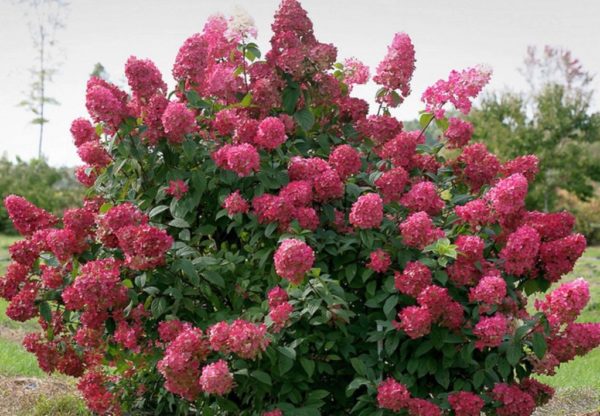
Wim's Red
This variety of red hydrangea is considered the best among gardeners due to its high decorativeness, unpretentiousness and frost resistance. The ratio of sterile and reproductive flowers is uniform. The petals are white when blooming, then pink, and in the fall - wine red. Short-term waterlogging of the soil is acceptable.
- The bush is compact, 2 m high, with strong, branched, straight shoots, dark red in color. The leaves are large, dark green with a reddish tint. In autumn, a metallic sheen appears, with shades of bronze, cherry, yellow or orange.
- The inflorescences are narrow pyramidal in shape, loose, 30-40 cm long.
- Flowering: June-October.
- Frost resistance: -29°С, zone 5. Shelter is required for the winter.
Wim's Red flowers have a strong honey aroma.
Confetti
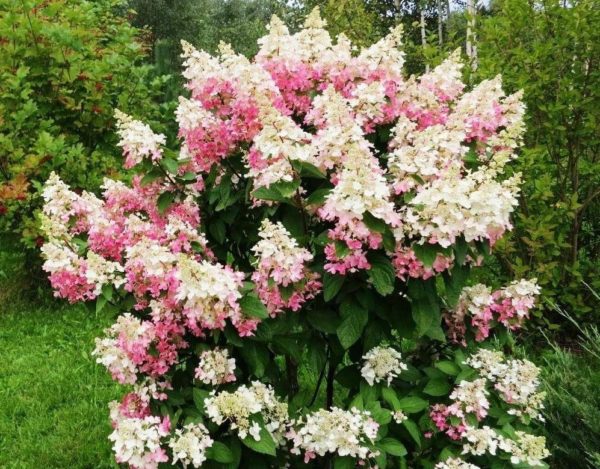
Confetti
An excellent variety for a small garden, growing in a container, or creating hedges. By mid-summer, the bush is covered with green inflorescences, gradually changing color to creamy white.Starting from the second week of flowering, the bases of the pyramid-inflorescences turn pink of varying degrees of saturation, turning the flowers into festive confetti. The plant is not demanding in terms of soil composition and lighting; it will look harmonious both in flower beds and on lawns.
- Height: 1.2 m. Stems are strong, scarlet, brown and orange.
- The inflorescences are cone-shaped, openwork, 30 cm long, arranged vertically. The leaves are dark green, pointed, with pronounced veins.
- Flowering: July-September.
- Frost resistance: -32°C, zone 4.
The color of Confetti greatly depends on the acidity of the soil. If you water the bushes with aluminum sulfate throughout the season, pink flowers will turn purple and white flowers will turn blue.
Strawberry Dessert
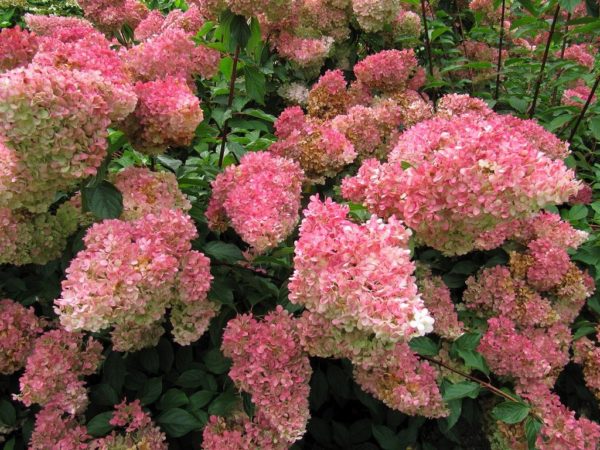
Strawberry Dessert
The opening flowers are creamy and then turn light pink and even red. New flowers continue to bloom until late summer - and the shrub simultaneously displays the beauty of all three color shades.
- Height: 2-3 m. Stems are dark red.
- The inflorescences are wide-conical and dense. The leaves are light green.
- Flowering: July-September.
- Frost resistance: -37°C, zone 4.
Magical Vesuvio
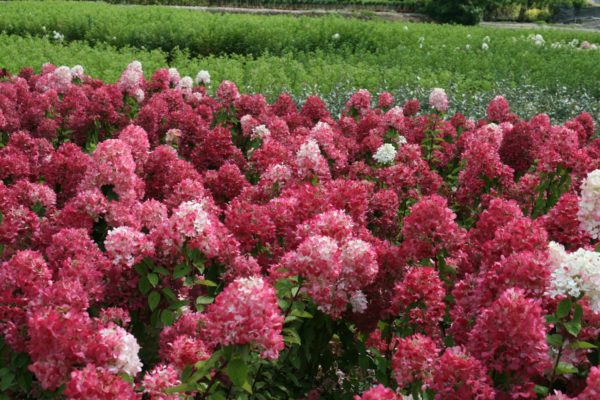
Magical Vesuvio
Beautiful inflorescences hold upright perfectly, do not droop, and consist of large sterile flowers. White inflorescences at the beginning of flowering quickly change color to pink, and at the end of flowering they become crimson. The variety is not susceptible to diseases and pests. It will grow well in both sun and partial shade.
- Height: 1.5 m, strong stems.
- The inflorescences are narrow pyramidal, large, the leaves are dark green.
- Flowering: July-September.
- Frost resistance: -35°C, zone 4.
Can be grown as a single plant, in mixed compositions or in standard form.
Prim'red
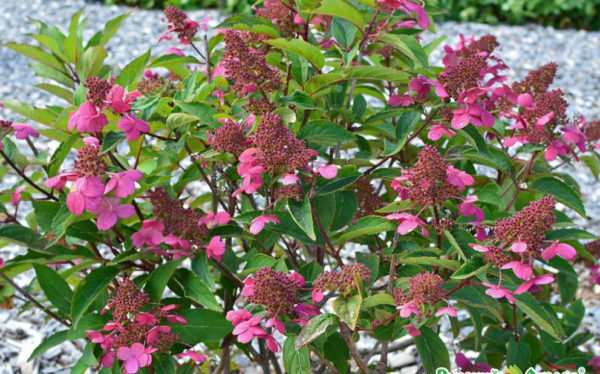
Prim'red
An early-blooming variety of hydrangea with sterile flowers ranging from pink to bright red. Prefers light partial shade. The soils are acidic and slightly acidic loams. It loves moisture and does not tolerate drought.
- Height: 1.5 m. Stems are thin and straight.
- The inflorescences are openwork cone-shaped, 15-20 cm long. The leaves are green, decorative.
- Flowering: May-August.
- Winter hardiness down to -30°C, zone 4.
Well suited for any garden compositions, can be used for untrimmed hedges, but planting under trees is not recommended.
Fraise Melba
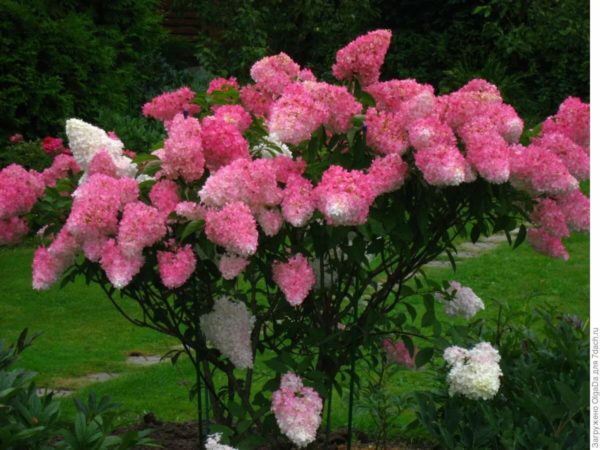
Fraise Melba
Feature of the variety "Fries Melba" is an unusual color transition from white to pink luxurious inflorescences. Towards the end of flowering, the pink tint becomes dominant, but the crown of the inflorescence always remains white. It has strong stems and does not require staking. Can grow in sun and partial shade. Bronze medalist at Plantarium 2014.
- Height: 1.5 m.
- The inflorescences are pyramidal, large, 40-50 cm long.
- Flowering: June-October.
- Frost resistance: -29°C, zone 5.
Hydrangea Fraze Melba can grow in one place for up to 40 years, so it is necessary to fertilize the soil well before planting.
Low growing varieties
In small garden plots, landscape designers prefer to use compact plants. Low-growing winter-hardy varieties of hydrangea, suitable for growing in the Moscow region, feel good not only in open ground, but also in flowerpots and flower beds.
Little Spooky
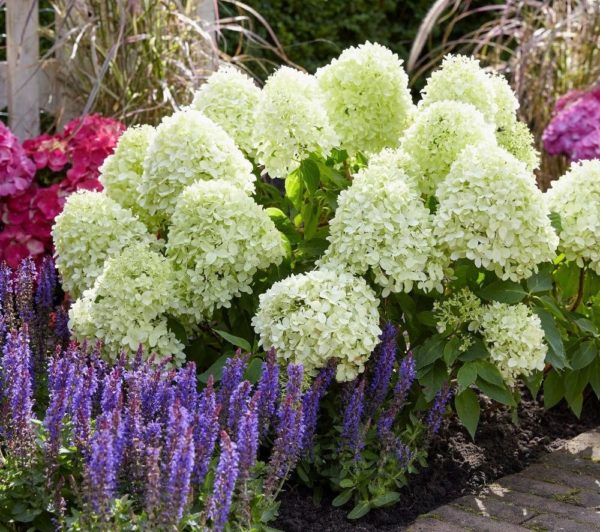
Low-growing hydrangea variety Little Spooky
Dwarf hydrangea with abundant flowering. The flowers are greenish-white. The bush is compact, suitable for growing in flowerpots on the veranda or balcony. The soil is moist, nutritious, breathable.
- Height: 0.5 m.
- The inflorescences are cone-shaped.
- Flowering: July-August.
- Location: sun, partial shade.
- Frost resistance: -25°C, zone 5.
An unpretentious, resistant variety, which during flowering is completely covered with lush greenish-white inflorescences.
Polistar
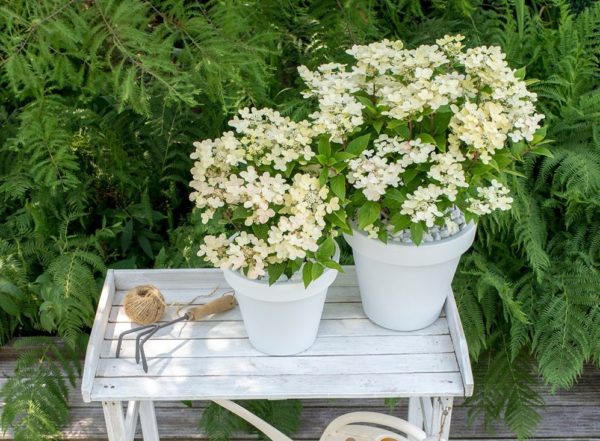
Polistar
Hydrangea "Polystar" The flowers are small, resembling stars. At the beginning of flowering, they are white, with a slight greenish tint. In July - salmon, and closer to August they acquire a dark pink color.
- Height: 0.5 m.
- The inflorescences are large, cone-shaped, 30 cm long. The leaves are small, green.
- Flowering: June-September.
- Frost resistance: –23°С, zone 5.
This variety grows well in the shade, suitable for growing on verandas and in the garden.
Little Quick Fire

Little Quick Fire
The low-growing variety Little Quick Fire blooms earlier than most other panicle hydrangeas. The flowers are showy, white, turning pink and then red as they bloom. Prefers a sunny or semi-shaded location with moist, well-drained soil.
- Height: 0.9-1.5 m.
- Inflorescences are vertical, up to 15 cm long.
- Flowering: June-September.
- Frost resistance: -35°C, zone 4.
Due to its compactness, it is well suited for growing in containers.
Mont Aso
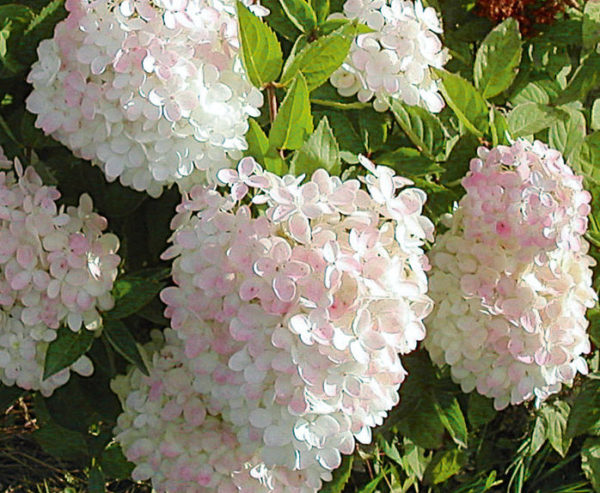
Mont Aso
The flowers bloom milky white, and towards the end of flowering, delicate pink highlights gradually appear on the petals. Suitable for a small garden and for growing in a container.Prefers slightly acidic soil in a sunny place.
- Height: 0.5-0.8 m.
- The inflorescences are large and heavy.
- Flowering: June-August.
- Frost resistance: -29°C, zone 5.
Little Lime
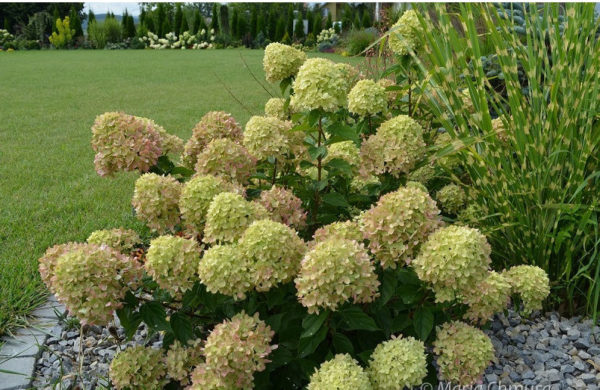
Little Lime
The shrub is compact, with flower clusters of a pleasant, light green hue on the upper shoots. Under bright sunlight they fade, becoming almost white. In autumn the original shade returns, but with a pink border around the edges of the petals. Little Lime flowers will only change color when grown in a sunny location.
- Height: 0.7-0.8 m. Leaves are green, velvety.
- Medium sized inflorescences. Due to the large number of panicles, the leaves are practically invisible.
- Flowering: July-October.
- Frost resistance: -32°C, zone 4.
Little Lime may suffer from gusty winds, which should be taken into account when choosing a planting site.
New varieties
Perle d Automne
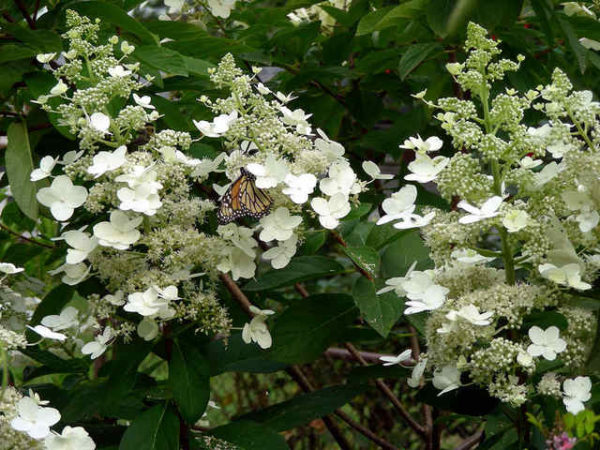
Perle d Automne
The new variety of hydrangea Perle d Automne or Autumn Pearl attracts the eye with openwork ivory-colored inflorescences. Half of the flowers in the inflorescence are reproductive, half are sterile (larger). The flowers are white at first, then acquire a delicate pearl pink color. The peculiarity of the variety is the colorful autumn color of the leaves (in orange tones).
- Height: 1.8 m.
- Soil: slightly acidic.
- Flowering: July-October.
- Frost resistance: -35°C, zone 4.
The winter hardiness of the variety is high, but in severe winters the shoots of young plants may freeze.
Selection
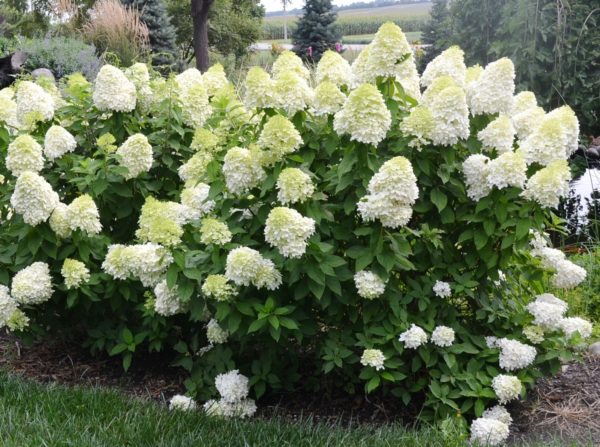
Selection
The inflorescences of the new variety Selection are large, dense, and the flowers change color throughout the season. The color change starts with a pistachio hue, turning to white and then pink. Prefers fertile, constantly moist, well-drained soil.Can grow in both sun and partial shade. Used for landscaping recreation areas and city parks.
- Height: 1-3 m, strong stems are colored red-brown.
- Inflorescences are dense, wide-conical panicles. The leaves are dark green.
- Soil: slightly acidic.
- Flowering period: June-October.
- Frost resistance: -35°C, zone 4.
Butterfly
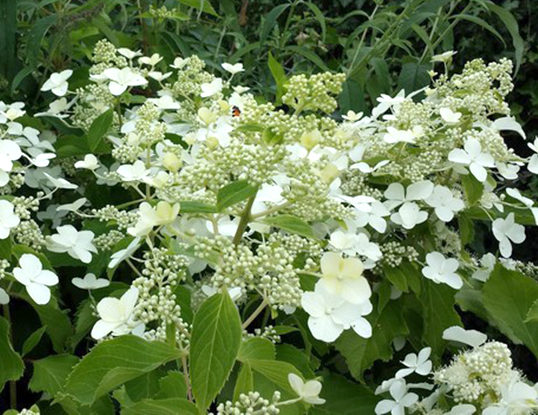
Butterfly
The flowers are white or pale pink. Strong, thick shoots do not break from strong gusts of wind. Suitable for growing in pots on balconies and verandas. The place is sunny or semi-shaded, the soil is nutritious, moist, loose.
- Height: 1-3 m.
- The inflorescences are large, cone-shaped.
- Flowering period: June-October.
- Winter hardiness: -30°C, zone 4.
The Butterfly variety is an excellent honey plant that attracts not only butterflies, but also bees to the garden.
Pastel Green
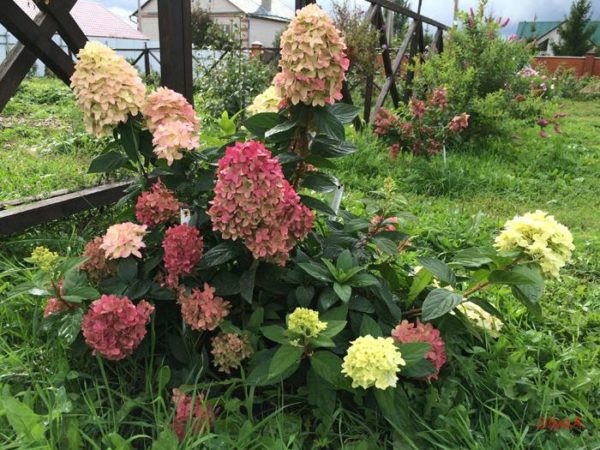
One of the best new varieties of hydrangea paniculata Pastel Green
The variety amazes with the continuous change in color of the petals throughout the season, creating an unusual shimmering color effect. The kaleidoscope of pink, white, cream, pale green flowers on each inflorescence is mesmerizing. Silver medal at the Plantarium exhibition - 2016.
- Height: 1.2 m.
- The inflorescences are round-conical, 15-20 cm in diameter.
- Flowering: July-September.
- Location: partial shade, shade.
- Frost resistance: -29°С, zone 5.
During flowering, the shades of the petals change from 2 to 6 times.
Don't forget to read:
Planting and care
The decorativeness and flowering of the future plant will depend on how the Hydrangea paniculata seedling is planted. Therefore, compliance with certain conditions must be taken into account when choosing a location, preparing the soil and caring for the seedling.
- The place for growing paniculata hydrangea should be sunny, with light shade, protected from strong winds.
- The soil for planting the crop is prepared drained, loose, with the addition of organic fertilizers, slightly acidic.
- It is recommended to plant paniculata hydrangea in the Moscow region in the spring, in early May.
- Before planting, the roots of the seedling must be inspected and dry ones removed, the rest shortened.
- Having placed the bush in the hole, the roots are straightened and covered with fertile soil, compacting it. The root collar is placed at soil level.
- The seedling is watered abundantly and the tree trunk is sprinkled with sawdust, pine needles or peat. This is necessary to retain moisture in the soil for a long time and slow down the growth of weeds.
Watering should be adjusted depending on the amount of precipitation. In hot summers, you will need to pour 3 buckets of warm water under the bush once a week (if there is mulch); in the rainy season, twice a month is enough.
Weeding and loosening is carried out as necessary.
Traditional feeding - slurry, potassium and nitrogen fertilizers.
Pruning is not necessary in the first 3 years, but from the fourth year pruning should be regular, in spring and autumn. Otherwise, the plant thickens, the shoots stretch and weaken.
Winter shelter for adult plants is not required. Only young seedlings or bushes planted in the fall are protected. Even if the shoots are partially damaged by frost, they will quickly recover in the spring. Successful cultivation of paniculata hydrangea in Siberia is quite possible if you choose zoned varieties with high winter hardiness.
Conclusion
Hydrangea paniculata can decorate any garden.The variety of varieties and types allows you to choose the best option for your site. Some varieties can be grown not only in unprotected soil, but also in containers at home.
Similar articles:
- Recommendations for caring for paniculata hydrangea
- Planting and caring for tree hydrangea
- Growing large-leaved (garden) hydrangea
- Thunberg barberry varieties
- The most beautiful varieties of weigela
- Description of spirea varieties with names and photos
- Forsythia shrub - planting, care and best varieties
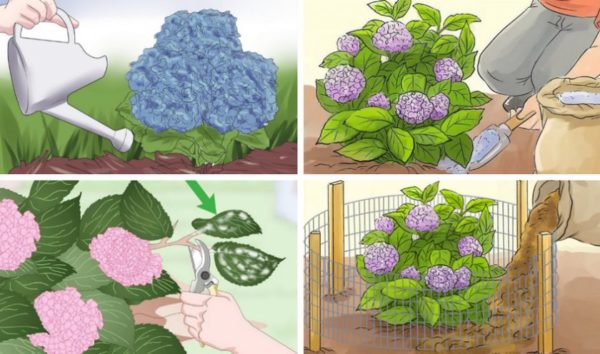

 (19 ratings, average: 4,47 out of 5)
(19 ratings, average: 4,47 out of 5) CUCUMBERS NEVER GET SICK, I'VE BEEN USING ONLY THIS FOR 40 YEARS! I SHARE A SECRET WITH YOU, CUCUMBERS ARE LIKE THE PICTURE!
CUCUMBERS NEVER GET SICK, I'VE BEEN USING ONLY THIS FOR 40 YEARS! I SHARE A SECRET WITH YOU, CUCUMBERS ARE LIKE THE PICTURE! You can dig a bucket of potatoes from each bush. Do you think these are fairy tales? Watch the video
You can dig a bucket of potatoes from each bush. Do you think these are fairy tales? Watch the video
 How our fellow gardeners work in Korea. There is a lot to learn and just fun to watch.
How our fellow gardeners work in Korea. There is a lot to learn and just fun to watch. Eye trainer. The author claims that with daily viewing, vision is restored. They don't charge money for views.
Eye trainer. The author claims that with daily viewing, vision is restored. They don't charge money for views. A 3-ingredient cake recipe in 30 minutes is better than Napoleon. Simple and very tasty.
A 3-ingredient cake recipe in 30 minutes is better than Napoleon. Simple and very tasty. Therapeutic exercises for cervical osteochondrosis. A complete set of exercises.
Therapeutic exercises for cervical osteochondrosis. A complete set of exercises. Which indoor plants match your zodiac sign?
Which indoor plants match your zodiac sign? What about them? Excursion to German dachas.
What about them? Excursion to German dachas.
Thanks for the article, but I think you mistakenly put a photo of the hydrangea “Dentel de Gorron” - Gorron’s Lace, instead of the indicated “Pearl of the Festival”, which has a completely different, denser inflorescence and a yellowish tint. Sincerely
Thanks for the note, Evgeniya. I was really wrong.
The last photo is not Pastel Green